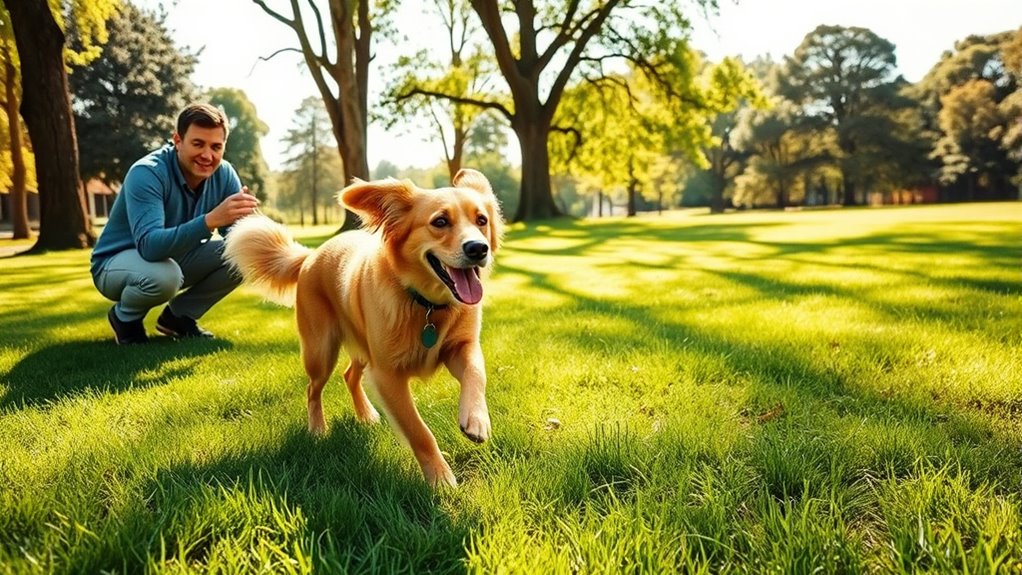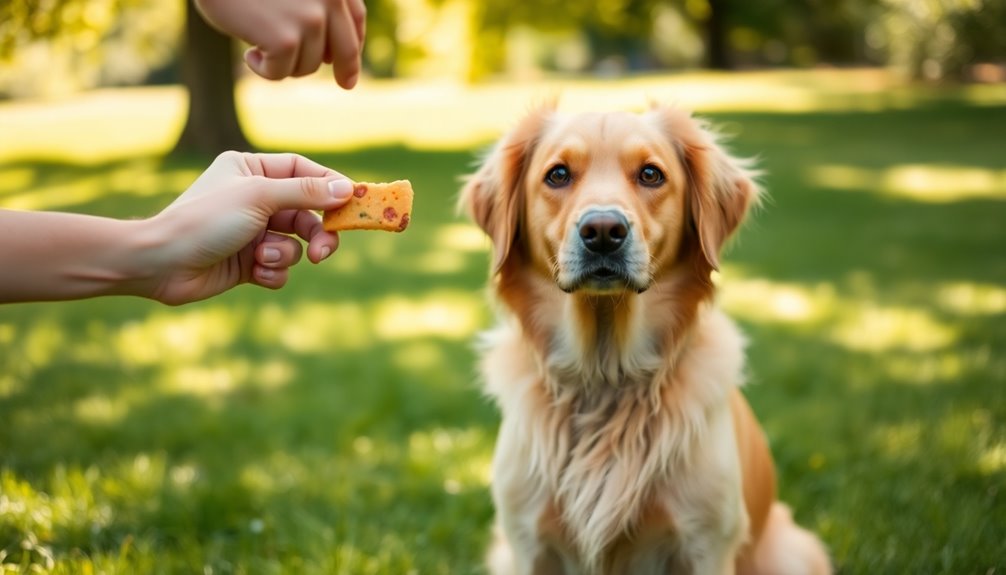To guarantee your dog comes when called every time, start training in low-distraction environments like your backyard, using treats, praise, or play as rewards. Be consistent and patient, gradually increasing difficulty by practicing in busier places while maintaining positive reinforcement. Practice regularly at controlled settings, reward immediately, and never punish delayed responses. Building trust and making returning fun are key—if you keep practicing these techniques, you’ll discover how to achieve reliable recall in any situation.
Key Takeaways
- Practice recall in low-distraction environments with positive rewards to build a strong foundation.
- Use consistent commands and immediate praise or treats to reinforce desired behavior.
- Gradually increase difficulty by training in busier areas and different settings for generalization.
- Avoid punishment; reward your dog generously for coming, even after delays or distractions.
- Regularly practice in controlled outdoor settings, like parks, to ensure reliability before off-leash play.

Have you ever wondered how to guarantee your dog comes back to you reliably in any situation? It’s a common concern for dog owners, especially when it comes to ensuring safety during outdoor adventures. One of the key elements in achieving reliable recall is mastering effective leash training techniques. These techniques help your dog associate positive experiences with coming when called, making it more likely they’ll obey commands even amidst distractions.
Start by practicing in low-distraction environments, like your backyard, where you can control the situation and focus on building a solid foundation. Use a leash to gently guide your dog and reinforce their response to recall commands. When your dog comes to you, immediately reward them with treats, praise, or play—whatever motivates them most. Consistency is essential; always respond the same way when they come, so they learn that returning to you results in good things. Over time, you can gradually increase the difficulty by practicing in busier areas, such as quiet parks or during walks, while still maintaining control with the leash.
Practice recall in calm settings with treats and consistent responses to build a strong foundation.
Dog park safety is an important aspect of recall training because it involves managing your dog’s behavior among other animals. Even if your dog is well-trained at home, unfamiliar sights and sounds can tempt them to run off or ignore commands. That’s why it’s vital to practice recall regularly in controlled settings before venturing into more stimulating environments. When you bring your dog to a dog park, keep them on a leash initially, and call them back periodically to reinforce the behavior. Praise and reward when they return, and only allow off-leash play once you’re confident in their responsiveness. Remember, a reliable recall minimizes risks like encounters with aggressive dogs or running into traffic, ensuring your dog’s safety and your peace of mind.
Consistency, patience, and positive reinforcement are your best tools for successful recall training. Use leash training techniques to build trust and obedience, and always prioritize dog park safety by practicing recall in controlled settings first. Never punish your dog for not coming right away; instead, make coming back to you a rewarding experience. Incorporating wall organization systems can help keep your training space tidy and free of distractions, reinforcing positive habits. Over time, your dog will learn that returning to you is always worth it, regardless of distractions. With dedication and proper training, you’ll develop a strong recall that keeps your dog safe, happy, and by your side in every adventure.
Frequently Asked Questions
How Long Does Recall Training Typically Take?
Recall training can take anywhere from a few weeks to several months, depending on your dog’s consistency and patience. You’ll reach training milestones as your dog reliably responds to commands, gradually increasing distractions. Use reinforcement techniques like treats, praise, and play to strengthen recall. Stay patient and consistent, and celebrate small successes along the way. With dedication, your dog will come when called, even in challenging situations.
Can Recall Training Be Effective With Stubborn Dogs?
Yes, recall training can be effective with stubborn dogs when you use consistent training and motivational techniques. You need to remain patient, persistent, and positive, reinforcing good behavior with treats, praise, or toys. Keep training sessions short and engaging, and always reward your dog for coming when called. By maintaining training consistency and incorporating motivational techniques, you’ll gradually overcome stubbornness and strengthen your dog’s recall skills.
What Should I Do if My Dog Doesn’T Respond?
If your dog doesn’t respond, stay calm and avoid punishment. Use positive reinforcement by rewarding them with treats or praise when they finally come. Be patient and consistent, practicing recall regularly in various environments to build their reliability. Remember, persistence pays off. Keep training sessions short, fun, and rewarding to encourage your dog to listen and respond promptly every time you call.
Is Recall Training Effective in High-Distraction Environments?
Recall training can be effective in high-distraction environments when you focus on distraction management and training consistency. You must gradually expose your dog to more challenging settings while reinforcing recall with positive rewards. Keep practicing regularly, stay patient, and adjust your approach as needed. This consistent effort builds your dog’s confidence and reliability, making recall more dependable even amid distractions. With persistence, your dog learns to respond regardless of the environment.
How Do I Maintain Recall Training Over Time?
You maintain recall training over time by consistently practicing with positive reinforcement, rewarding your dog every time they respond correctly. Use clear cues and keep training sessions short and frequent to reinforce good behavior. Incorporate consistency strategies like practicing in different environments and gradually increasing distractions. This steady approach helps your dog understand that coming when called is always rewarding, ensuring reliable recall even in challenging situations.
Conclusion
Remember, recall training is like planting a seed of trust and freedom. With patience and consistency, you’re nurturing a bond that blossoms into unwavering responsiveness. When your dog comes running back, it’s like a lighthouse guiding you home through any storm. Keep practicing, and watch as your connection grows stronger—your shared journey a shining beacon of reliability and love, illuminating every adventure ahead.










